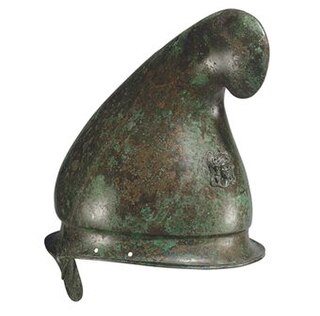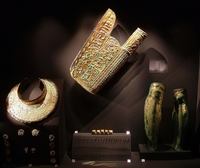
The 4th century BCE started the first day of 400 BCE and ended the last day of 301 BCE. It is considered part of the Classical era, epoch, or historical period.

Philip II of Macedon was the king (basileus) of the ancient kingdom of Macedonia from 359 BC until his death in 336 BC. He was a member of the Argead dynasty, founders of the ancient kingdom, and the father of Alexander the Great.

Philip III Arrhidaeus was king of the ancient Greek kingdom of Macedonia from 323 until his execution in 317 BC. He was a son of King Philip II of Macedon by Philinna of Larissa, and thus an elder half-brother of Alexander the Great. Named Arrhidaeus at birth, he assumed the name Philip when he ascended to the throne.

Vergina is a small town in Northern Greece, part of Veria municipality in Imathia, Central Macedonia. Vergina was established in 1922 in the aftermath of the population exchanges after the Treaty of Lausanne and was a separate municipality until 2011, when it was merged with Veroia under the Kallikratis Plan.

Central Macedonia is one of the thirteen administrative regions of Greece, consisting of the central part of the geographical and historical region of Macedonia. With a population of almost 1.8 million, it is the second most populous region in Greece after Attica.

Manolis Andronikos was a Greek archaeologist and a professor at the Aristotle University of Thessaloniki.

A composite bow is a traditional bow made from horn, wood, and sinew laminated together, a form of laminated bow. The horn is on the belly, facing the archer, and sinew on the outer side of a wooden core. When the bow is drawn, the sinew and horn store more energy than wood for the same length of bow. The strength can be made similar to that of all-wood "self" bows, with similar draw-length and therefore a similar amount of energy delivered to the arrow from a much shorter bow. However, making a composite bow requires more varieties of material than a self bow, its construction takes much more time, and the finished bow is more sensitive to moisture.

A larnax is a type of small closed coffin, box or "ash-chest" often used in the Minoan civilization and in Ancient Greece as a container for human remains—either a corpse or cremated ashes.

The sarissa or sarisa was a long spear or pike about 5 to 7 meters in length. It was introduced by Philip II of Macedon and was used in his Macedonian phalanxes as a replacement for the earlier dory, which was considerably shorter. These longer spears improved the strength of the phalanx by extending the rows of overlapping weapons projecting towards the enemy. After the conquests of Alexander the Great, the sarissa was a mainstay during the Hellenistic era by the Hellenistic armies of the diadochi Greek successor states of Alexander's empire, as well as some of their rivals.

The Kingdom of Macedon possessed one of the greatest armies in the ancient world. It is reputed for the speed and efficiency with which it emerged from Greece to conquer large swathes of territory stretching from Egypt in the west to India in the east. Initially of little account in the Greek world, it was widely regarded as a second-rate power before being made formidable by Philip II, whose son and successor Alexander the Great conquered the Achaemenid Empire in just over a decade's time.
Meda of Odessos, died 336 BC, was a Thracian princess, daughter of the king Cothelas a Getae, and wife of king Philip II of Macedon. Philip married her after Olympias.
In Greek mythology, Eucleia or Eukleia was the female personification of glory and good repute.

The Vergina Sun (Greek: Ήλιος της Βεργίνας, romanized: Ilios tis Vergínas, lit. 'Sun of Vergina', also known as the Star of Vergina, Vergina Star or Argead Star, is a rayed solar symbol first appearing in ancient Greek art of the period between the 6th and 2nd centuries BC. The Vergina Sun proper has sixteen triangular rays, while comparable symbols of the same period variously have sixteen, twelve, eight or six rays.

The Phrygian helmet, also known as the Thracian helmet, was a type of helmet that originated in ancient Greece, towards the close of the classical period and was used throughout the Hellenistic world until well into the period of the Roman Republic. Widely used by Greek, Macedonian, Diadochi, Italic peoples, Etruscans, Thracian, Phrygian and Dacian warriors throughout the Hellenistic and Roman republican period and by some ethnicities into Roman imperial times.
Eurydice, often referred to as Adea Eurydice, was the Queen consort of Macedon, wife of Philip III and daughter of Amyntas IV and Cynane.

The Argead dynasty, also known as the Temenid dynasty was an ancient Macedonian royal house of Dorian Greek provenance. They were the founders and the ruling dynasty of the kingdom of Macedon from about 700 to 310 BC.

The ceremonial shield of the Tombs of Vergina is a decorative shield found in the Royal Tombs at Aigai in Northeast Greece. The shield was found alongside other lavish grave goods and the remains of family members of Alexander the Great, including Philip II of Macedon. The ceremonial shield dates to the late fourth century B.C.E. and was discovered in 1976.

Aegae or Aigai, also Aegeae or Aigeai (Αἰγέαι) was the original capital of Macedon, an ancient kingdom in Emathia in northern Greece. Its site is located within the modern town of Vergina.

The Museum of the Royal Tombs of Aigai (Vergina) is located 75 km west of Thessaloniki, Greece, centered around the royal tombs built by the ancient Kingdom of Macedon at Aigai. The underground museum containing the burial cluster of Philip II of Macedon began construction in 1993 and was inaugurated in 1997. Exhibits are presented in four connected areas, including the Palace, the royal burial cluster of the Temenid dynasty (burial cluster "C"), the burial cluster of Philip II, and a gateway entrance with a semi-open-air exhibition of the sculptures found in the city sanctuaries and the restored upper floor of the Palace of Philip's facade. The tombs and other archaeological sites of Aigai were inscribed on the UNESCO World Heritage List in 1996 because of its exceptional architecture and testimony to the transition between city-states and empires in European civilization.

The Golden Larnax is a 4th-century BC closed coffin discovered in the Macedonian Royal tombs at Vergina in Greece. It has been proposed that it contained the remains of King Philip II of Macedon.



















